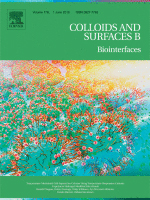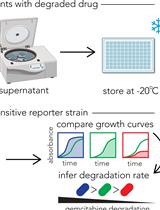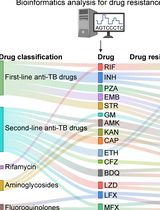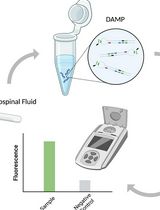- EN - English
- CN - 中文
Determination of Antibacterial Activity of Film Coatings against Four Clinically Relevant Bacterial Strains
薄膜敷层对4种与临床相关菌株的抑菌活性测定
发布: 2021年01月20日第11卷第2期 DOI: 10.21769/BioProtoc.3887 浏览次数: 4638
评审: Juan Facundo Rodriguez AyalaChao JiangFilipa Vaz
Abstract
Antibacterial coatings have currently gained great importance in biomedical technology investigations. Because of the spatial arrangement of the film coatings, evaluation of antibacterial activity presents a new challenge regarding traditional bacterial counting methods. In this protocol, four clinically relevant pathogens, Salmonella typhimurium, Escherichia coli, Pseudomonas aeruginosa, and Staphylococcus aureus were incubated on titania mesostructured thin film coatings for 24 h. Then, cell viability was studied considering three methods: counting of the number of colony forming units (CFU), live/dead staining, and quantification of extracellular DNA in suspension. Firstly, bacterial count was determined by the standard plate-count technique. Secondly, bacteria membrane integrity was evaluated by utilization of two fluorescent dyes, which allow distinction between live (membrane intact) and dead (membrane disrupted) bacteria. Lastly, extracellular DNA was quantified by spectrophotometry. In this manner, the three aforementioned techniques enabled the study of bacterial viability by qualitative and quantitative analyses.
Keywords: Antibacterial activity (抑菌活性)Background
Functional coatings are being widely investigated owing to the valuable advantages they offer to the area of materials engineering. They are capable of introducing new surface properties, with no changes in the material bulk characteristics. Among their functionalities, antibacterial coatings have demonstrated great importance for biomedical applications (Mateescu et al., 2015). In this sense, nanotechnology provides substantial tools for the fabrication of antibacterial coatings. Our group has achieved the synthesis of nanostructured coatings with broad spectrum bactericidal activity, without utilizing antibiotics or bacteria repelling substances (Scilletta et al., 2019). Here, only the superstructure is responsible for the bactericidal activity. To find the specific superstructure capable of bacteria killing many assays with distinct coatings configurations have been performed. All the coatings were composed of poloxamer block copolymers (also named as Pluronic®) within a titania matrix. Thus, film coatings were prepared using two copolymers which differ in the length of the hydrophilic and hydrophobic portions (Pluronic F127 and Pluronic P123). The quantities of the copolymers varied systematically, therefore modifying the titania: pluronic mol ratios. These modifications modulate the mesophase, which we proved is directly related to the bactericidal capacity. The mesostructured titania thin film coatings were synthesized by the sol-gel method in combination with evaporation-induced self-assembly of the pluronic micelles and deposited by spin-coating on glass substrates (Scilletta et al., 2019).
In order to find the best bactericidal performance, the aforementioned distinct coating configurations were compared based on their antibacterial efficacy. We utilized three methods to determine the most effective antibacterial coating: counting of the number of colony forming units (CFU), live/dead staining, and quantification of extracellular DNA in suspension. To perform the counting of CFU after bacterial incubation on the films we modified a previous protocol by Merritt et al. (2006). Afterwards, coatings presenting the best bactericidal performance were further studied to clarify the mechanism of bacteria killing. In this regard, fluorescent staining with SYTO 9 and propidium iodide (PI) was utilized to determine the integrity of the bacteria membrane. After incubating the bacterial inoculum on the films, the recovered suspension was dyed with this mixture. PI only diffuses into damaged membrane cells and binds to DNA with high affinity, labeling those cells in red. SYTO 9 only stains live cells with intact membranes, labeling them in green. This protocol is a modification of the one published by Smith and Hunter (2008). Lastly, the presence of extracellular DNA was studied as an indicator of cell membrane disruption. To perform this determination we modified the previous protocols from Chen and Cooper (2002) and from Yuan et al. (2019).
As a result of the three considered aspects, this protocol describes an integral approach for the determination of antibacterial activity of film coatings. The protocol can be utilized to evaluate the effects of any coatings on bacterial viability, which includes bactericidal superstructures like the one studied by us, and drug-loaded coatings, either with traditional antibiotics or novel antibacterial agents.
Materials and Reagents
50 ml sterile Erlenmeyer flasks (DWK Life Science, Duran®, catalog number: 2121617 )
5 ml sterile Borosilicate tubes (IVA®, catalog number: VID-01548 )
1.5 ml sterile Eppendorf centrifuge tubes (Eppendorf, catalog number: 022364111 )
2-20 µl, 20-100 µl, 100-1,000 µl Kartell pluripet micropipettes (Kartell LABWARE, catalog numbers: 13000 , 13210 , 13220 ) and 1-10 ml Acura® manual micropipette (Socorex Swiss, catalog number: 825/835 )
Sterile pipette tips 1-200 µl, 100-1,000 µl (Corning®, catalog numbers: S4860 , S9032)
Sterile 50, 100 and 1,000 ml borosilicate measuring cylinders (VILABO, catalog numbers: 3501114 , 3501115 , 3501118 )
Sterile Petri dish glass plates (80 mm diameter) (Brand®, catalog number: BR455732 )
Bacterial strains Salmonella typhimurium (LT2), Escherichia coli K12, Pseudomonas aeruginosa (PAO1) and Staphylococcus aureus (ATCC 29213 )
Neutral detergent (Extran®, Merck Millipore, catalog number 140000 )
Milli-Q Water
Acetone (Merck, catalog number 67-64-1 )
Isopropanol (Merck, catalog number 3979-51-9 )
Titanium tetrachloride (Merck, catalog number , 7550-45-0 )
Pluronic® F-127 (Sigma-Aldrich, catalog number 9003-11-6 )
Pluronic® P-123 (Carbo synth, catalog number 9003-11-6 )
Glass slides (YEGREN® , catalog number: 7101 )
Cover glasses (Merck, catalog number C9056-1CS )
Cell culture plate (Sigma®, catalog number SIAL0516-50EA )
Plastic box (15 cm x 20 cm x 5 cm)
Paper towel (WypAll* X 60 Jumbo Roll, KCWW, Kimberly-Clark, catalog number: 30218593 )
Inoculating loop (DeconTM, catalog number: MP 19025 )
Glycerol for molecular biology, ≥ 99.0% (Sigma-Aldrich, catalog number: G5516-500ML )
Distilled water (G-BIOSCIENCES, catalog number: 786-1713 )
Immersion oil (Leica, standar and type “F”, CAS Number: 195371-10-9 )
Tryptone (OXOID, catalog number: LP0042 )
Yeast extract (Merck, catalog number: 103753 )
Granulated agar (Difco, catalog number 214530 )
Sodium Chloride (NaCl) (Biopack, catalog number: 1646.08 )
SYTOTM 9 Green Fluorescent Nucleic Acid Stain (Invitrogen, catalog number S34854 )
Propidium Iodide (Invitrogen, Catalog number P1304MP )
LB medium (see Recipes)
LB agar solid medium (see Recipes)
4 M NaCl solution (see Recipes)
Saline solution (see Recipes)
Staining SYTO 9/PI solution (see Recipes)
Titania mesostructured thin film coatings (see Recipes)
Equipment
50 ml Erlenmeyer flasks
Inoculation loop
Conventional incubator shaker (New Brunswick Scientific Co., INC, model: G25 )
UV-Vis Spectrophotometer (Biotraza, model: 752 )
Autoclave (Hirayama HICLAVETM, model: HVE-50 )
Hot air oven sterilizer (Dalvo Instrumentos, model: OHR/T )
Vortex (Velp, model: ZV3, 201251076 )
Epifluorescence microscope (Olympus, model: BX51 )
Incubation stove (Precision, Scientific Group, model 4, catalog number: 31483 )
Bunsen burner (EiscoTM, catalog number CH0091B )
Nanodrop 2000 (Thermo Scientific, NanoDrop®, catalog number: ND-2000 )
Refrigerated centrifuge (Hanil Scientific, model: Combi 514R )
Spin coater (Laurell Technologies Corporation, model: WS-650-23B )
Procedure
文章信息
版权信息
© 2021 The Authors; exclusive licensee Bio-protocol LLC.
如何引用
Scilletta, N. A., Pezzoni, M., Desimone, M. F., Soler-Illia, G. J. D. A. A., Bellino, M. G. and Catalano, P. N. (2021). Determination of Antibacterial Activity of Film Coatings against Four Clinically Relevant Bacterial Strains. Bio-protocol 11(2): e3887. DOI: 10.21769/BioProtoc.3887.
分类
微生物学 > 抗微生物试验 > 抗细菌试验
细胞生物学 > 基于细胞的分析方法 > 集落形成
分子生物学 > DNA > DNA 定量
您对这篇实验方法有问题吗?
在此处发布您的问题,我们将邀请本文作者来回答。同时,我们会将您的问题发布到Bio-protocol Exchange,以便寻求社区成员的帮助。
Share
Bluesky
X
Copy link













